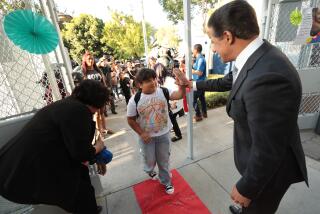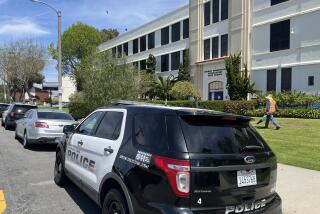Student Drug Use Remains at ’90 Level : Substance Abuse: While cocaine use is down, LSD use has increased among older students.
A recent San Diego County schools study offers a sobering glimpse of drug abuse among youth:
* Nearly one-quarter of fourth-grade students surveyed last spring drank beer or wine at least once during the previous six months. Among 11th-grade students, the figure was 62%.
* One-quarter of 11th-grade students had five or more drinks at least once in the previous two weeks; two-fifths were sick at least once because of overconsumption.
* More than 40% of 11th-grade students drove or rode in a car while drinking during the previous two weeks. One in 10 drove or rode in a car more than six times while drinking.
* Eleven percent of 11th-grade students reported using LSD at least once.
Released Friday by the San Diego County Office of Education, the figures quantify the rise and decline of drug use among students.
The survey, administered countywide during March and April, was a 12-page questionnaire given to 9,823 students in grades 4, 7, 9 and 11, said UCLA researcher Rodney Skager, who conducted the survey. Individual school and district figures were not released.
Commissioned by the California attorney general’s office, Skager has run similar studies since 1985.
The results will be used by county administrators to plan next year’s prevention and counseling programs, said Loretta Middleton, director of the county education office’s Student Well-Being Unit.
Skager said the level of drug use among San Diego County students in 1990 and 1992 stayed roughly the same. However, cocaine use declined among all four grades surveyed, while LSD use increased dramatically among older students.
The survey found that more than 10% of 11th-graders surveyed this year have used LSD, more than double the figure in 1990.
Skager attributed the growing popularity of LSD to the manufacture of less potent, less hazardous forms of the hallucinogen, and “aggressive marketing” on campus.
Cocaine use has not proliferated among youths who are enrolled in school, as was predicted in the mid-’80s, Skager said. The drug in its various forms--including powder, rock or crack--has remained largely a “street drug.” In San Diego County, cocaine was used by 4.5% of 11th-grade students, down from 5.7% in 1990. Statewide, 6.6% of the students surveyed this year identified themselves as cocaine users.
A bright spot in the study, Skager said, was the shift in the sources of knowledge about drugs. The most frequently cited source of information was “classes in school,” a departure from earlier sources such as peers and an individual’s own experimentation with drugs.
Countywide, 60% to 70% of students cited classes as the source of information, much more than in state surveys conducted in the mid-1980s. In 1992, parents were also cited as sources more frequently than in the past.
Pupils completed the questionnaire voluntarily and anonymously, but officials expect some under-reporting, making for conservative figures, Skager said.
More to Read
Sign up for Essential California
The most important California stories and recommendations in your inbox every morning.
You may occasionally receive promotional content from the Los Angeles Times.










